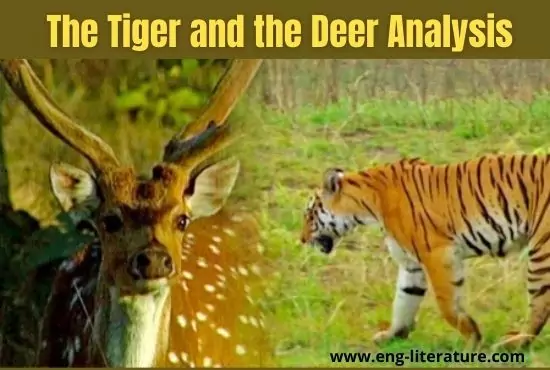The Tiger and the Deer by Analysis
Aurobindo’s genius manifested itself not only in his major works but also in exquisite shorter poems. In small proportions also we see just beauties and life becomes perfect in short measures too. In shorter poems like “The Tiger and the Deer“, Aurobindo extends infinite riches in form and content. Though the poem is short, it is highly thought-provoking. The fearful symmetry of the strong, cruel beauty in nature does not escape him. The control of verse, the technical skill and sheer sensibility cannot be missed. It expresses a general truth and a prophesy.
The poem is a metaphysical lyric of great significance and can be classed with ‘Rishi’, ‘Rose of God’ and ‘Thought and Paraclete’, and above all the third part of Savitri -the debate between Death and Savitri. Here Sri Aurobindo reflects on the paradox that beauty and wildness go together in nature. While the Tiger represents “The strong cruel beauty”, the deer stands for “the mild harmless beauty” in nature. It is puzzling to see this duality in nature. But the poet foresees a day from which the tiger crouches and leaps no more in the dangerous heart of the forest and as the mammoth shakes no more the plains of Asia, still then shall the beautiful wild deer drink from the coolness of great pools in the shadow of the leaves. He prophesies that evil will disappear totally from this earth one day and only good prevails. Then the earth becomes a paradise.
In the last lines of the poem, the poet says that the mighty perish in their might and the slain survive the slayer. The mighty abusing their might indulge in the dangerous activity of self-destruction. With the disappearance off tamasic forces only the satvic remain. This idea seems to contradict the basic idea of Darwin’s Evolutionary Theory, the survival of the fittest. It is not the physically fittest that survive but the spiritually fittest. While Darwin emphasizes the physiological and anatomical details, Sri Aurobindo emphasises the inner evolution of beings, in other words, spiritual evolution.
“The Tiger and the Deer” is a remarkable lyric written in free quantitative verse which is left to find out its own line by line rhythm and unity. It is not bound by any law of metre. In it each line resolves itself into four groups of words and the groups vary in length from each other. The last two lines have only three such groups. Aurobindo has used very appropriate words to represent the fierceness and ferocity of the tiger by such words as ‘crouching and slouching’. As against its dreadful form, he refers to the ‘gleaming eyes’ and ‘soft soundless paws.’ Again the innocence and softness of the deer is gently described in the statement “Death leaped on the beautiful wild deer as it drank unsuspecting from the great pool in the coolness and shadow of the forest.”
The poem brilliantly projects the bright and burning terror of the forest and at the same time presents the splendid future possibility of terror being exceeded by peace and death by life. The terror of the forest is the tiger that brings unprovoked disaster to the deer. The tiger is called ‘pitiless’ because it kills innocent animals like the deer. The picture of the deer, having no suspicion of the fatal attack by the tiger, is painted in a single line.
“And it fell and torn died remembering its mate left sole
in the deep woodland”.
Then Aurobindo refers to the thought of a bright future free from fear and violence when all shall enjoy full life and health. He concludes the poem with a fine prophesy and it is an everlasting statement:
“The mighty perish in their might
The slain survive the slayer.”
The poet means to state that the powerful will remain controlled and die without harming the weak, like the deer. In the days of perfect law and order, the weak will not be killed by the mighty and may even live longer than the latter. The poem may also be read as a symbolic expression of the present day beastly power, the representative of which the tiger is crushing the innocent and the beautiful well represented by the ‘deer’. But the poet is quite optimistic that the present state will not last long and that a bright day will bring to end all this muddy affair. Thus the poem makes an indelible mark in the minds of the readers.

Hello, Viewers! Besides being the Founder and Owner of this website, I am a Government Officer. As a hardcore literary lover, I am pursuing my dream by writing notes and articles related to Literature. Drop me a line anytime, whether it’s about any queries or demands or just to share your well-being. I’d love to hear from you. Thanks for stopping by!

It’s nice to read your writeups to understand more about great authors like Aurobindo
Thanka you